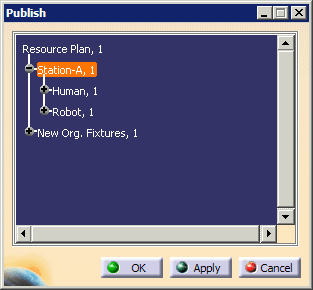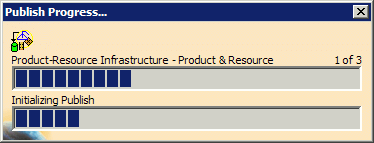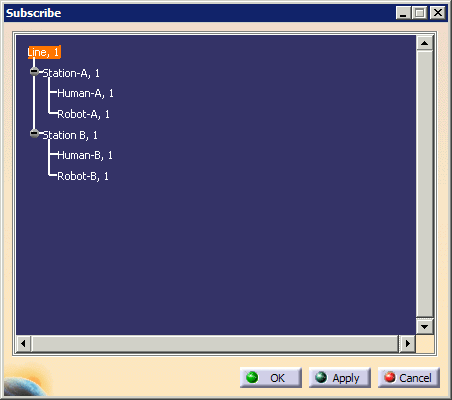Collaborative simulation allows for multiple simulation detailings (created by different users) to be viewed concurrently for a given process. This means that a single user, such as a manager, can view a parent-level process with the simulations that have been saved for each of the sub-processes. As an example scenario, when an assembly line has multiple stations and each station has its own simulation data defined, the parent line-level process can be viewed with the simulation of the separate sub-processes.
Collaborative simulation is achieved by the following methods:
-
Publishing simulation data.
Publish application data allows the creator of detailing data to make that data visible to other users. Upon selecting a V5 object, the applicative and simulation data belonging to the selected object (and its children) is published and saved in the Manufacturing Hub. -
Subscribing to simulation data.
Subscribe application data allows a user to view data that has been previously published by another user and load that data in a V5 session.
- This scenario assumes a Manufacturing Hub project that has been saved with at least one detailing.
Publishing data
-
Select Publish application data
 .
The Publish dialog is displayed:
.
The Publish dialog is displayed:

-
Select the node in the PPR tree for which data is to be published. If a parent node is selected, the data for any child nodes will also be published.
-
Select OK or Apply to publish the data associated to the selected node and its children, if any exist. (Selecting OK publishes the data and closes the Publish dialog box. Selecting Apply publishes the data and leaves the dialog box open.)
The Publish Progress... dialog box is shown to display the current publishing status:
Publishing notes
-
A user must have proper rights to an object in order to modify it and subsequently publish it.
-
Any changes must be saved before publishing. If a publish is attempted when there are unsaved changes, a dialog box reminds the user that changes must first be saved.
Subscribing to data
-
Select Subscribe application data
 .
The Subscribe dialog is displayed, and shows the resource
structure tree representation:
.
The Subscribe dialog is displayed, and shows the resource
structure tree representation:

Nodes having published data that can be subscribed to feature an icon
 in the resource tree.
in the resource tree. -
Select the desired node in the PPR tree.
-
Select OK. All published data for the selected node and its children will be loaded.
A progress bar is shown to to display the current subscribing status.
When the command is completed, any applicative data that has been published (robot tasks, human tasks, attachments, profiles, etc.) has been loaded with all its respective links. All links that the activities under these tasks have to other products and resources are also restored.
Supported resource data
The following data types can be published:
- General Resource data
- Device Mount
- Resource Tasks
- Robot Tasks
- Human Tasks
- Device Tasks
- Active Task link between the task and the Operation
- Tag Groups and Tags (limited only to those used in Tasks)
- Robot Controller data
- Mounted Tools
- Motion profiles
- Tool profiles
- Object profiles
- Accuracy profiles
- Auxiliary Axes Definition
- Assembly Simulation Activities (as part of Resource Behavior)
- Assembly Move Activity
Limitations
-
Only one set of published data is created and saved per object. If multiple publishes are performed on the same object, any existing published data is overwritten.
-
There is no automatic synchronization of data after a Publish has occurred. If changes are made in DPM after data has been published and a new detailing is saved, these changes must also be published.
-
Managed versioning of published data is not supported in V5. If versions of published data are required, they must be created and maintained in Process Engineer.
-
User attributes data is not supported.
-
Data cannot be individually published to multiple instances of the same resource (created via Drag and Drop). Because each of the instances refer to the same resource object, the resource will only store the data that was most recently published.
-
If a Simulation activity links to a part inside a black box, the Part Instance Name of the linked part in the black box cannot be changed. If this name is changed, the link will no longer resolve properly.
-
Links are not guaranteed to resolve when subscribing to published data from a resource that has been copied in the Manufacturing Hub.
-
There should not be two robot tasks with the same name in a given session.
- The usage of Work System Components (WSC) for modeling robots, devices, and humans is not supported. V5 data (such as robot tasks, device tasks, etc.) cannot be published if a Work System Component resource is also included with that data.
-
If a set of data for a resource is published and the graphic object to which this resource is pointing is subsequently changed, the links from/to this published data may not correctly resolve.
-
Upon subscribing to published data on a given node and subsequently deleting all the subscribed data, the data will be removed from the Manufacturing Hub on subsequent publishing. However, the
 icon will remain on that node in the resource tree in the Publish and
Subscribe dialog boxes.
icon will remain on that node in the resource tree in the Publish and
Subscribe dialog boxes.